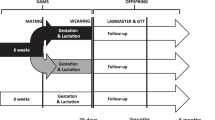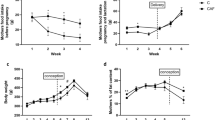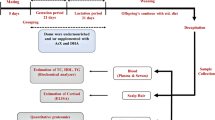Abstract
Background/Objectives:
Vitamin D is an anti-inflammatory nutrient and a determinant of bone health. Some prospective studies suggest that maternal vitamin D status is positively associated with offspring bone mass. We found that serum concentrations of lipopolysaccharide (LPS), an inflammatory molecule related to adiposity, insulin resistance and bone resorption, is lower in healthy mouse offspring exposed to high dietary vitamin D during pregnancy and lactation. LPS reaches the circulation via the gut. This study investigated whether maternal vitamin D programs metabolic, gut and bone health of male offspring in an obesogenic environment.
Methods:
C57BL/6J dams received an AIN-93G diet with high (H) or low (L) vitamin D during pregnancy and lactation. At weaning, offspring remained on their dam’s vitamin D level (LL or HH) or were switched (LH or HL) and fed a high fat (44.2%) and sucrose (19.8%) diet. Glucose response, adiposity, systemic inflammation (LPS, cytokines), intestinal permeability and mass, strength and microarchitecture of trabecular and cortical bone were assessed in 7-month-old male offsprings.
Results:
Higher maternal dietary vitamin D resulted in lower intestinal permeability (fecal albumin, P=0.010) and benefited trabecular but not cortical bone structure at the distal femur (higher trabecular number, P=0.022; less trabecular separation, P=0.015) and lumbar vertebra 2 (bone volume/total volume%, P=0.049). Higher maternal and offspring vitamin D resulted in lower fasting glucose (HH versus LL, P=0.039) and serum LPS concentrations (dam diet, P=0.011; pup diet, P=0.002). Higher offspring vitamin D resulted in lower epididymal fat pad relative weight (P=0.006). The serum concentrations of IL-6 and TNF-α did not differ among groups.
Conclusions:
Maternal dietary vitamin D beneficially programs intestinal permeability and systemic LPS concentration, which is accompanied by stronger trabecular bone in an obesogenic environment. Thus, the gut may mediate vitamin D effects. Moreover, optimizing vitamin D in early life may be critical for later health.
This is a preview of subscription content, access via your institution
Access options
Subscribe to this journal
Receive 12 print issues and online access
$259.00 per year
only $21.58 per issue
Buy this article
- Purchase on Springer Link
- Instant access to full article PDF
Prices may be subject to local taxes which are calculated during checkout




Similar content being viewed by others
References
Goulding A, Jones IE, Taylor RW, Williams SM, Manning PJ . Bone mineral density and body composition in boys with distal forearm fractures: a dual-energy x-ray absorptiometry study. J Pediatr 2001; 139: 509–515.
Goulding A, Jones IE, Williams SM, Grant AM, Taylor RW, Manning PJ et al. First fracture is associated with increased risk of new fractures during growth. J Pediatr 2005; 146: 286–288.
Dimitri P, Bishop N, Walsh JS, Eastell R . Obesity is a risk factor for fracture in children but is protective against fracture in adults: a paradox. Bone 2012; 50: 457–466.
Compston JE, Watts NB, Chapurlat R, Cooper C, Boonen S, Greenspan S et al. Obesity is not protective against fracture in postmenopausal women: GLOW. Am J Med 2011; 124: 1043–1050.
Premaor MO, Compston JE, Fina Aviles F, Pages-Castella A, Nogues X, Diez-Perez A et al. The association between fracture site and obesity in men: a population-based cohort study. J Bone Miner Res 2013; 28: 1771–1777.
Yeh FJ, Grant AM, Williams SM, Goulding A . Children who experience their first fracture at a young age have high rates of fracture. Osteoporos Int 2006; 17: 267–272.
Heaney RP, Abrams S, Dawson-Hughes B, Looker A, Marcus R, Matkovic V et al. Peak bone mass. Osteoporos Int 2000; 11: 985–1009.
Javaid MK, Crozier SR, Harvey NC, Gale CR, Dennison EM, Boucher BJ et al. Maternal vitamin D status during pregnancy and childhood bone mass at age 9 years: a longitudinal study. Lancet 2006; 367: 36–43.
Zhu K, Whitehouse AJ, Hart PH, Kusel M, Mountain J, Lye S et al. Maternal vitamin D status during pregnancy and bone mass in offspring at 20 years of age: a prospective cohort study. J Bone Miner Res 2014; 29: 1088–1095.
Soder O . Perinatal imprinting by estrogen and adult prostate disease. Proc Natl Acad Sci USA 2005; 102: 1269–1270.
Nutrition UNESCO Double Burden of Malnutrition—A Common Agenda. 33rd Annual Session of the Standing Committee on Nutrition. United Nations: Geneva, Switzerland, 2006.
Lucas A . Long-term programming effects of early nutrition: implications for the preterm infant. J Perinatol 2005; 25 : S2–S6.
Yu S, Cantorna MT . Epigenetic reduction in invariant NKT cells following in utero vitamin D deficiency in mice. J Immunol 2011; 186: 1384–1390.
Jahani R, Fielding KA, Chen J, Villa CR, Castelli LM, Ward WE et al. Low vitamin D status throughout life results in an inflammatory prone status but does not alter bone mineral or strength in healthy 3-month-old CD-1 male mice. Mol Nutr Food Res 2014; 58: 1491–1501.
Cani PD, Amar J, Iglesias MA, Poggi M, Knauf C, Bastelica D et al. Metabolic endotoxemia initiates obesity and insulin resistance. Diabetes 2007; 56: 1761–1772.
Miller MA, McTernan PG, Harte AL, Silva NF, Strazzullo P, Alberti KG et al. Ethnic and sex differences in circulating endotoxin levels: A novel marker of atherosclerotic and cardiovascular risk in a British multi-ethnic population. Atherosclerosis 2009; 203: 494–502.
Mehta NN, McGillicuddy FC, Anderson PD, Hinkle CC, Shah R, Pruscino L et al. Experimental endotoxemia induces adipose inflammation and insulin resistance in humans. Diabetes 2010; 59: 172–181.
Kong J, Zhang Z, Musch MW, Ning G, Sun J, Hart J et al. Novel role of the vitamin D receptor in maintaining the integrity of the intestinal mucosal barrier. Am J Physiol Gastrointest Liver Physiol 2008; 294: G208–G216.
Froicu M, Cantorna MT . Vitamin D and the vitamin D receptor are critical for control of the innate immune response to colonic injury. BMC Immunol 2007; 8: 5.
Smith BJ, Lerner MR, Bu SY, Lucas EA, Hanas JS, Lightfoot SA et al. Systemic bone loss and induction of coronary vessel disease in a rat model of chronic inflammation. Bone 2006; 38: 378–386.
Pasoto SG, Yoshihara LA, Maeda LC, Bernik MM, Lotufo PA, Bonfa E et al. Osteoporotic hip fractures in non-elderly patients: relevance of associated co-morbidities. Rheumatol Int 2012; 32: 3149–3153.
Halade GV, Rahman MM, Williams PJ, Fernandes G . High fat diet-induced animal model of age-associated obesity and osteoporosis. J Nutr Biochem 2010; 21: 1162–1169.
Zhao LJ, Jiang H, Papasian CJ, Maulik D, Drees B, Hamilton J et al. Correlation of obesity and osteoporosis: effect of fat mass on the determination of osteoporosis. J Bone Miner Res 2008; 23: 17–29.
Kaludjerovic J, Ward WE . Neonatal exposure to daidzein, genistein, or the combination modulates bone development in female CD-1 mice. J Nutr 2009; 139: 467–473.
Otsu N . A threshold selection method from gray-level histograms. IEEE Trans Syst Man Cybern 1979; 9: 62–66.
Johnell O, Kanis JA, Oden A, Johansson H, De Laet C, Delmas P et al. Predictive value of BMD for hip and other fractures. J Bone Miner Res 2005; 20: 1185–1194.
Harvey NC, Sheppard A, Godfrey KM, McLean C, Garratt E, Ntani G et al. Childhood bone mineral content is associated with methylation status of the RXRA promoter at birth. J Bone Miner Res 2014; 29: 600–607.
Devlin MJ, Bouxsein ML . Influence of pre- and peri-natal nutrition on skeletal acquisition and maintenance. Bone 2012; 50: 444–451.
Wolever TM, Mehling C . Screening for diabetes and impaired glucose tolerance (IGT): Lack of sensitivity of fasting plasma glucose. Can J Diab Care 1999; 23: 23–28.
Bourlon PM, Billaudel B, Faure-Dussert A . Influence of vitamin D3 deficiency and 1,25 dihydroxyvitamin D3 on de novo insulin biosynthesis in the islets of the rat endocrine pancreas. J Endocrinol 1999; 160: 87–95.
Beaulieu C, Kestekian R, Havrankova J, Gascon-Barre M . Calcium is essential in normalizing intolerance to glucose that accompanies vitamin D depletion in vivo. Diabetes 1993; 42: 35–43.
Marcotorchino J, Tourniaire F, Astier J, Karkeni E, Canault M, Amiot MJ et al. Vitamin D protects against diet-induced obesity by enhancing fatty acid oxidation. J Nutr Biochem 2014; 25: 1077–1083.
Sergeev IN, Song Q . High vitamin D and calcium intakes reduce diet-induced obesity in mice by increasing adipose tissue apoptosis. Mol Nutr Food Res 2014; 58: 1342–1348.
Hrncir T, Stepankova R, Kozakova H, Hudcovic T, Tlaskalova-Hogenova H . Gut microbiota and lipopolysaccharide content of the diet influence development of regulatory T cells: studies in germ-free mice. BMC Immunol 2008; 9: 65.
Guo S, Al-Sadi R, Said HM, Ma TY . Lipopolysaccharide causes an increase in intestinal tight junction permeability in vitro and in vivo by inducing enterocyte membrane expression and localization of TLR-4 and CD14. Am J Pathol 2013; 182: 375–387.
Chen SW, Wang PY, Zhu J, Chen GW, Zhang JL, Chen ZY et al. Protective effect of 1,25-dihydroxyvitamin d3 on lipopolysaccharide-induced intestinal epithelial tight junction injury in caco-2 cell monolayers. Inflammation 2015; 38: 375–383.
Hartmann P, Chen P, Wang HJ, Wang L, McCole DF, Brandl K et al. Deficiency of intestinal mucin-2 ameliorates experimental alcoholic liver disease in mice. Hepatology 2013; 58: 108–119.
Cani PD, Possemiers S, Van de Wiele T, Guiot Y, Everard A, Rottier O et al. Changes in gut microbiota control inflammation in obese mice through a mechanism involving GLP-2-driven improvement of gut permeability. Gut 2009; 58: 1091–1103.
Droke EA, Hager KA, Lerner MR, Lightfoot SA, Stoecker BJ, Brackett DJ et al. Soy isoflavones avert chronic inflammation-induced bone loss and vascular disease. J Inflamm 2007; 4: 17.
Moreira AP, Texeira TF, Ferreira AB, Peluzio Mdo C, Alfenas Rde C . Influence of a high-fat diet on gut microbiota, intestinal permeability and metabolic endotoxaemia. Br J Nutr 2012; 108: 801–809.
Cortese R, Lu L, Yu Y, Ruden D, Claud EC . Epigenome-microbiome crosstalk: a potential new paradigm influencing neonatal susceptibility to disease. Epigenetics 2016; 11: 205–215.
Assa A, Vong L, Pinnell LJ, Avitzur N, Johnson-Henry KC, Sherman PM . Vitamin D deficiency promotes epithelial barrier dysfunction and intestinal inflammation. J Infect Dis 2014; 210: 1296–1305.
Bischoff SC, Barbara G, Buurman W, Ockhuizen T, Schulzke JD, Serino M et al. Intestinal permeability: a new target for disease prevention and therapy. BMC Gastroenterol 2014; 14: 189.
Gernand AD, Schulze KJ, Stewart CP, West Jr KP, Christian P . Micronutrient deficiencies in pregnancy worldwide: health effects and prevention. Nat Rev Endocrinol 2016; 12: 274–289.
Lagishetty V, Misharin AV, Liu NQ, Lisse TS, Chun RF, Ouyang Y et al. Vitamin D deficiency in mice impairs colonic antibacterial activity and predisposes to colitis. Endocrinology 2010; 151: 2423–2432.
Ooi JH, Li Y, Rogers CJ, Cantorna MT . Vitamin D regulates the gut microbiome and protects mice from dextran sodium sulfate-induced colitis. J Nutr 2013; 143: 1679–1686.
van der Meijden K, Buskermolen J, van Essen HW, Schuurman T, Steegenga WT, Brouwer-Brolsma EM et al. Long-term vitamin D deficiency in older adult C57BL/6 mice does not affect bone structure, remodeling and mineralization. J Steroid Biochem Mol Biol 2015. e-pub ahead of print 7 September 2016 doi:10.1016/j.jsbmb.2015.09.004.
Hunt JR, Hunt CD, Zito CA, Idso JP, Johnson LK . Calcium requirements of growing rats based on bone mass, structure, or biomechanical strength are similar. J Nutr 2008; 138: 1462–1468.
Reeves PG, Rossow KL, Lindlauf J . Development and testing of the AIN-93 purified diets for rodents: results on growth, kidney calcification and bone mineralization in rats and mice. J Nutr 1993; 123: 1923–1931.
Acknowledgements
This project was funded by a matching grant from the Centrum Foundation of Pfizer Consumer Healthcare Research Innovation Fund and the Department of Nutritional Sciences at the University of Toronto to EMC and WEW, and from a Natural Sciences and Engineering Research Council of Canada (NSERC) Discovery grant to EMC (Grant # RGPIN 356124-2013). The μCT system was purchased with funding from the Canada Foundation for Innovation to WEW (Grant #222084). Christopher R Villa was partially funded by the Banting and Best Diabetes Centre-Novo Nordisk Studentship and Tamarack Graduate Award in Diabetes Research and by an Ontario Graduate Scholarship. Wendy Ward holds a Canada Research Chair in Bone and Muscle Development. Elena Comelli holds the Lawson Family Chair in Microbiome Nutrition Research at the University of Toronto. We wish to thank Hayley Craig-Barnes of the Analytical Facility for Bioactive Molecules of The Centre for the Study of Complex Childhood Diseases, The Hospital for Sick Children, Toronto, Canada for measurements of serum 25(OH)D3 concentrations.
Author information
Authors and Affiliations
Corresponding author
Ethics declarations
Competing interests
The authors declare no conflict of interest.
Additional information
Supplementary Information accompanies this paper on International Journal of Obesity website
Supplementary information
Rights and permissions
About this article
Cite this article
Villa, C., Chen, J., Wen, B. et al. Maternal vitamin D beneficially programs metabolic, gut and bone health of mouse male offspring in an obesogenic environment. Int J Obes 40, 1875–1883 (2016). https://doi.org/10.1038/ijo.2016.177
Received:
Revised:
Accepted:
Published:
Issue Date:
DOI: https://doi.org/10.1038/ijo.2016.177
This article is cited by
-
Micronutrients in early life and offspring metabolic health programming: a promising target for preventing non-communicable diseases
European Journal of Clinical Nutrition (2023)
-
Maternal high protein-diet programs impairment of offspring’s bone mass through miR-24-1-5p mediated targeting of SMAD5 in osteoblasts
Cellular and Molecular Life Sciences (2021)
-
Colonic Bacteroides are positively associated with trabecular bone structure and programmed by maternal vitamin D in male but not female offspring in an obesogenic environment
International Journal of Obesity (2018)
-
The Global Epidemic of the Metabolic Syndrome
Current Hypertension Reports (2018)
-
Nutritional Programming of Bone Structure in Male Offspring by Maternal Consumption of Citrus Flavanones
Calcified Tissue International (2018)



